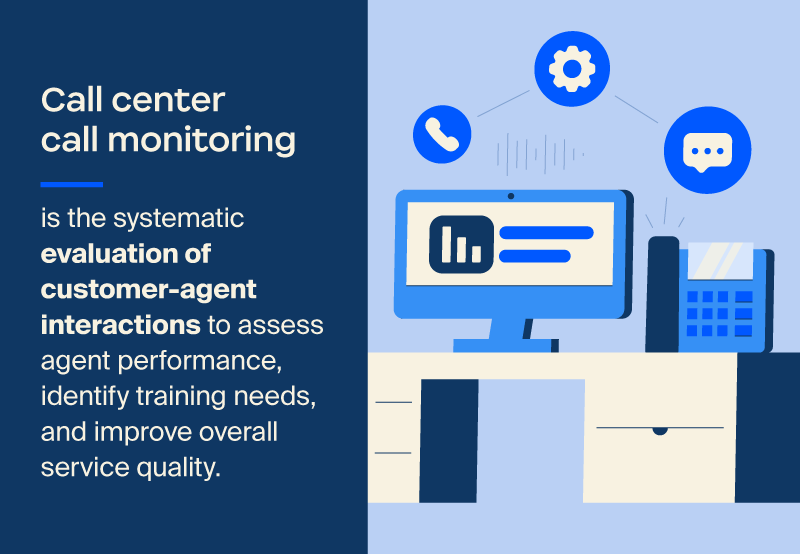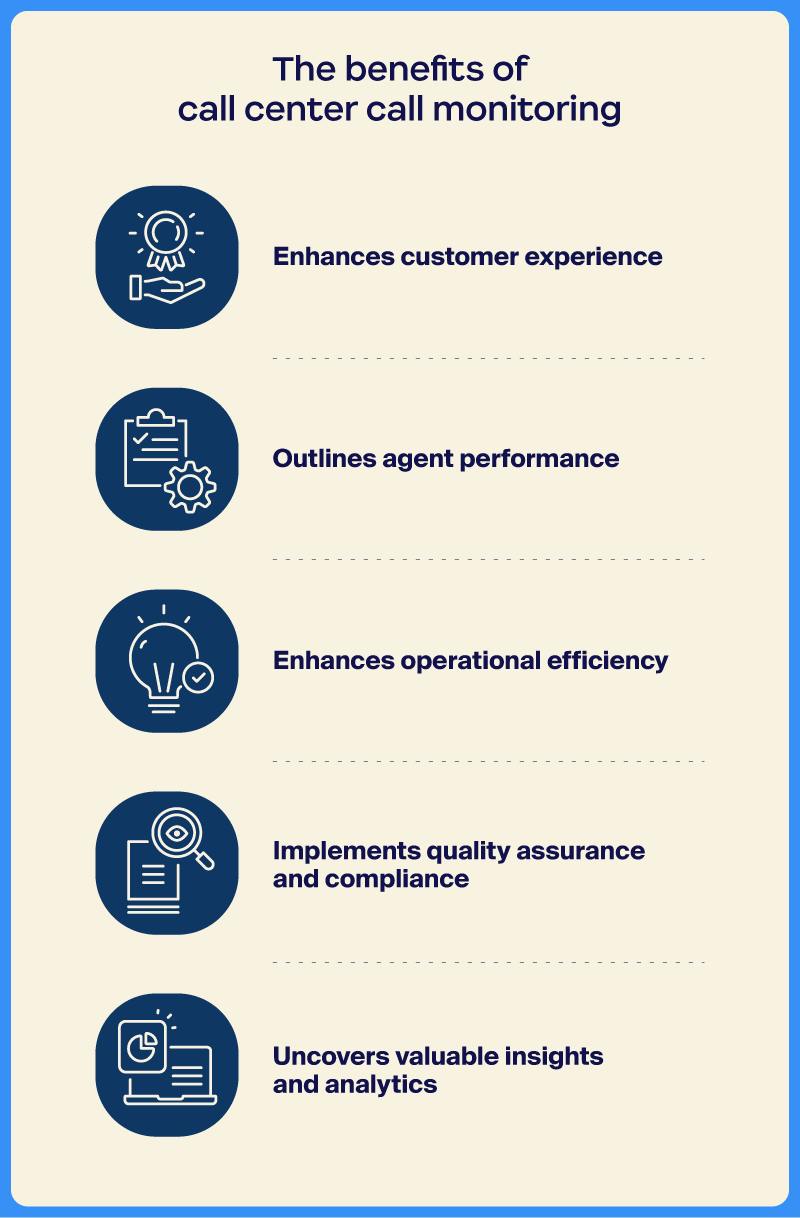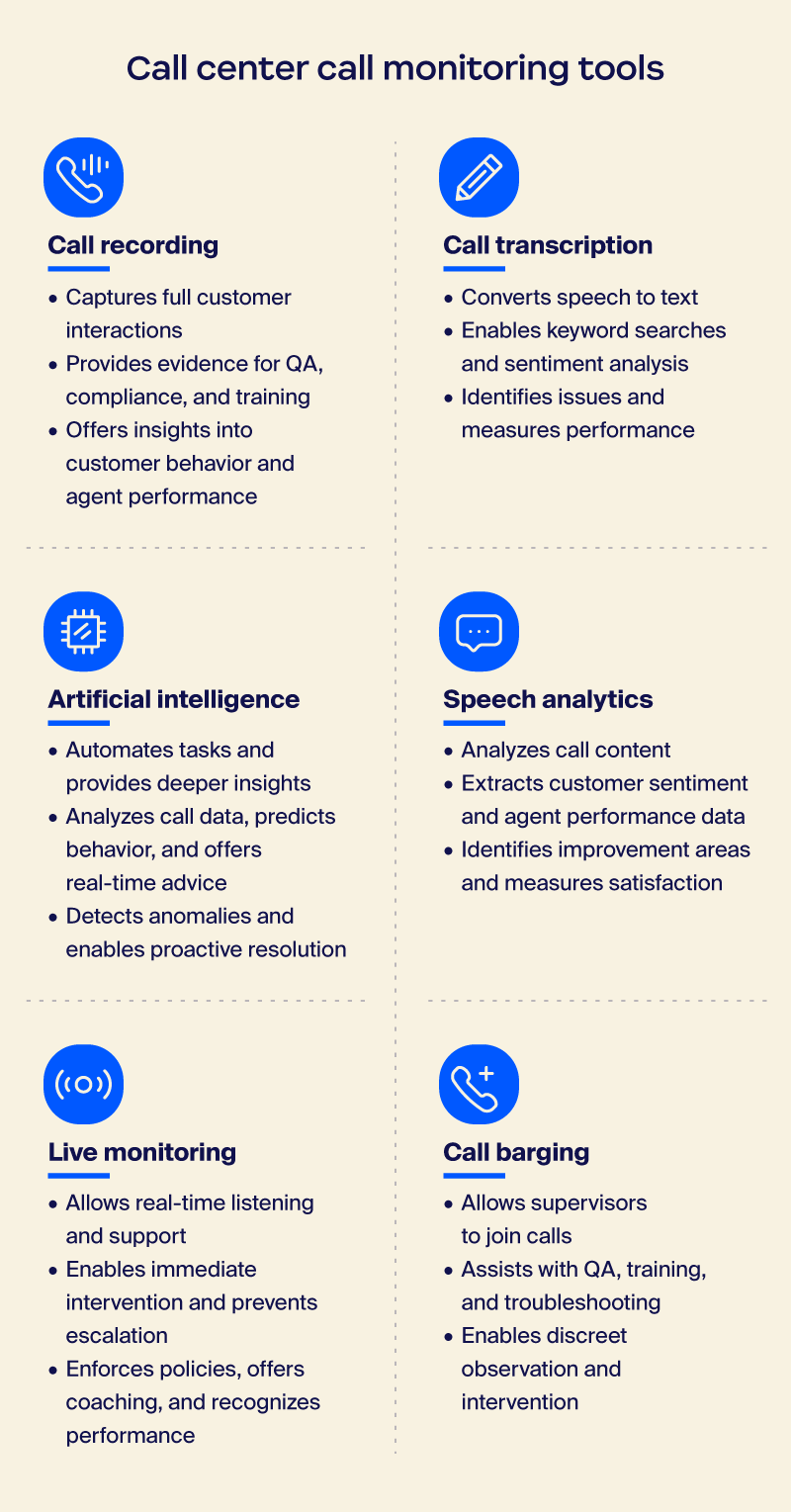
Meet Zoom AI Companion, your new AI assistant!
Boost productivity and team collaboration with Zoom AI Companion, available at no additional cost with eligible paid Zoom plans.
Updated on October 07, 2024
Published on October 07, 2024


Call center call monitoring helps companies deliver exceptional customer service. By evaluating customer interactions with agents, businesses can gain valuable insights into agent performance, identify areas for improvement, and determine whether agents are adhering to company standards.
But what does this process involve? How do you analyze agent behavior? And what’s the impact on customer satisfaction?
In this article, we’ll explore the ins and outs of call center monitoring, including the benefits, tools, and best practices to help you uncover unsatisfactory agent performance and how to improve.
Call center call monitoring is the practice of systematically reviewing recorded customer interactions with agents to evaluate performance, identify training needs, and enhance overall service quality.
It’s a common practice, especially during employee onboarding, to closely monitor new hires so they’re adequately prepared for customer interactions. Call monitoring provides valuable insights you can transform into effective training materials by analyzing real-world scenarios.
Beyond new hire evaluation, call monitoring is an ongoing process that helps maintain high service standards. It allows organizations to identify trends, address customer concerns promptly, and recognize agents who excel in their roles. Through call data analysis, companies can refine customer service strategies and create a more positive customer experience.

Call center call monitoring has many benefits, from uncovering unsatisfactory agent performance to maintaining quality standards. Let’s review some benefits of call center monitoring.

Call monitoring directly impacts customer satisfaction. By analyzing interactions, businesses can use call monitoring to identify areas where service falls short and implement corrective action.
Pinpointing recurring customer issues allows for targeted solutions, reducing frustration and increasing loyalty. You’ll be able to recognize agents who consistently deliver exceptional service, empowering them to become role models and elevating overall call center performance.
Call center call monitoring provides agents with valuable feedback for growth. By identifying strengths and weaknesses, supervisors can offer tailored coaching and training.
This personalized approach enhances agent confidence and skill, increasing efficiency and first-call resolution rates. Recognizing top performers also boosts morale and fosters a competitive spirit within the team.
Call monitoring is a powerful tool for identifying operational inefficiencies. By analyzing call data, businesses can uncover bottlenecks, optimize processes, and reduce handle times.
For example, identifying frequently asked questions can help you create self-service resources for customers, freeing agents to handle more complex issues. Monitoring call volume patterns also helps optimize staffing levels, helping to ensure optimal resource allocation.
Call center call monitoring is essential for maintaining quality standards and adhering to regulatory requirements. By consistently evaluating interactions, businesses can identify and address compliance risks.
Call monitoring also encourages agents to follow company policies and procedures. Regular audits through call center quality monitoring can help provide evidence of compliance and help mitigate potential legal issues.
Call monitoring generates a wealth of data that can be analyzed to uncover trends and patterns. By understanding customer sentiments and behaviors, businesses can make data-driven decisions to improve products and services.
They can also analyze agent performance metrics and provide insights into training needs, staffing requirements, and overall call center efficiency. This data-driven approach fosters a culture of continuous improvement.
Now that you’re more familiar with the definition of call center call monitoring and its benefits, it’s time to unlock the tools you’ll need. Here are some call center monitoring tools to look for when searching for call center monitoring software.
Call recording captures entire customer interactions, providing a comprehensive record for analysis. These recordings can serve as useful tools for quality assurance, compliance, and agent training purposes. They offer a detailed view of customer behaviors, agent performance, and potential areas for improvement.
Call transcription converts spoken words into text, making it easier to analyze call content. This tool enables efficient keyword searches, sentiment analysis, and key information identification. Transcripts can help create training materials, identify common issues, and measure agent performance against specific metrics.
AI-powered tools enhance call monitoring by automating tasks and providing deeper insights. These systems can analyze call data to identify trends, predict customer behavior, and offer agents real-time recommendations. AI can detect anomalies, such as compliance violations or customer dissatisfaction, helping to enable proactive resolution.
Speech analytics delves into call content, extracting valuable information about customer sentiment, agent performance, and product feedback. By analyzing keywords, phrases, and tone of voice, businesses can identify areas for improvement, measure customer satisfaction, and optimize call center operations.
Live monitoring allows supervisors to listen in on live calls, providing real-time guidance and support to agents. This tool enables immediate intervention when needed, helps prevent issues from escalating, and helps employees adhere to company policies. It also offers opportunities for coaching and recognition of exceptional performance.
Call barging enables supervisors to join an active call without the customer’s knowledge. This tool is primarily used for quality assurance, training, and troubleshooting purposes. It allows for discreet observation of agent performance and intervention in case of issues.

When it comes to call center monitoring, it’s important to define objectives, tailor feedback, and leverage the right tools. Let’s review some of these best practices.
Establishing clear call center call monitoring goals is essential so you know what to look for. Determine specific metrics to measure agent performance, such as average handle time, first call resolution rate, and customer satisfaction. These metrics should align with overall business objectives and provide a clear framework for evaluation.
Agents possess valuable insights into customer interactions. Involving them in the call monitoring process fosters a sense of ownership and accountability. Seek their input on evaluation criteria, identify areas for improvement, and encourage them to self-assess their performance.
Leverage call monitoring data to provide personalized agent feedback. Analyze individual performance metrics to identify strengths and weaknesses. Focus on specific behaviors and provide actionable recommendations for improvement. Regular, constructive feedback is crucial for agent development.
Create a positive and supportive work environment where agents feel valued and encouraged to grow. Emphasize the importance of call center call monitoring as a tool for development, not punishment. Celebrate successes and provide ongoing coaching and training to help agents improve.
Utilize call monitoring software to streamline the process and maximize efficiency. Look for tools that offer features such as call recording, transcription, speech analytics, and quality management. The right technology can help you gather valuable data, automate tasks, and provide actionable insights.
Unleash the power of Zoom Contact Center and Workforce Engagement Management to optimize your call center operations. Gain deeper insights into agent performance, improve customer satisfaction, and streamline workflows with our unified platform. Experience the future of contact center excellence with Zoom.